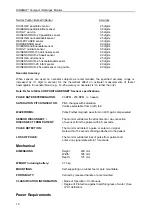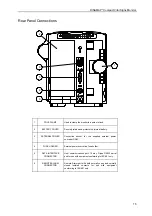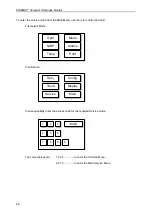
DINAMAP*
Compact
Vital Signs Monitor
19
points on the high precision resistor chain of RV3, R70, R74-77 which equate to 10°C and 37°C. Any
changes in VREFI or voltage to frequency transfer characteristic can therefore be accommodated within
reason.
The temperature circuit is powered from an isolated 5 volt and
±
9 volt supply (5 and
±
15V on revision
04 and earlier), these supplies are generated by the isolated power supply module PM100. Calibration
of the voltage and hence frequency in the temperature reference circuit is achieved by the use of
resistor trees, attached to a stable reference voltage. This reference, VREFI is 3.24 volts (nominal) and
is generated from the isolated 5 volt line by D2, adjustment provided by RV2. Thus RV2 will adjust the
overall calibration of voltage ranges X0, X1 and X2. Additional adjustment of the calibration points X0
and X1 is provided by RV3 in their resistor tree. Together RV2 and RV3 are used to calibrate the
temperature circuit.
The VREFI may be measured across TP3 and TP2, and the PRED_TEMP_F signal may be measured
across TP9 and TP6.
2.4.3 NIBP System
The non-invasive blood pressure system measures blood pressure and pulse rate. The NIBP
measurement circuitry is located on the Main Board 8610AB or 8760AB.
To measure blood pressure, a reference voltage generated by IC23 supplies a bridge pressure
transducer ML1 to enable it to convert air pressure from the pneumatics system into an analogue
voltage. This voltage is amplified by the instrumentation amplifier IC5. The unfiltered signal PT1 is
routed to into an eight channel analogue multiplexer, IC20. When selected, the output signal is
buffered by IC21 as signal BUF_ANA_MUX and enters the ADC IC23. The digitised output of the ADC
is presented to IC24, an octal buffer/line driver, from where it is transmitted to the data bus and the
system processor. Pressure transducer excitation reference PT1_REF from the output of IC2 also
enters the analogue multiplexer IC20. When selected, it provides a pressure transducer excitation
reference value to the system processor. The control signals for the multiplexer (ASEL0 ~ ASEL2) are
generated by the system processor.
The pulse rate component (typically one percent) of the cuff pressure signal is filtered and separated
from the PT1 pressure signal. The low pass filter formed around IC9a allows the low frequency pulse
signal through whilst attenuating any higher frequency noise. The signal is then ac coupled by the high
pass filter of C20 & R41 in order to strip off the small pulse rate signal from the cuff pressure signal.
The pulse signal is then amplified by IC9b before being applied to high pass filter on the input of the
analogue gain amplifier IC12. The output from IC12 FPT1 is routed to the analogue multiplexer IC20
for selection by the system processor. The analogue switch IC7 is controlled by the system processor,
it is used to clamp and apply offset signals into the filtered pressure measurement channel to generate
self test functions.
The system software includes an internal on-line self-test feature for the FPT channel at power-up and
after each non-STAT mode determination. The FPT test feature tests the band pass filter response of
the FPT1 signal channel.
2.4.4 Pneumatics System
The pneumatics system provides air pressure for the NIBP cuff, manifolding for control of cuff pressure,
and an overpressure signal to the system processor and pneumatic control logic GAL if the pressure
exceeds 300 mmHg in adult mode or 158 mmHg in neonate mode. The system is comprised of a
pneumatic pump, pressure transducer, overpressure detection circuitry, power control circuit, and two
solenoid-operated pneumatic valves. Air from the pump is routed through the dump valve to the cuff
output manifold.
The pneumatics system provides control of the pump by commands received from the system
processor. The PUMP_ON signal from latch IC3 on the Main Board is passed to the pneumatic control
logic GAL IC1 on the power supply board. The GAL produces a pump drive signal which turns on FET






























